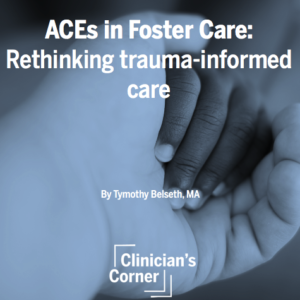ACE’s in Foster Care: Rethinking trauma-informed care
Want to discuss the article more on Facebook Live? Vote for it above! 
Important to Know:
- Children in foster care have complex trauma histories and the system itself generates traumatic experiences.
- Trauma and neglect are proven to have significant repercussions on brain development, which leads to other issues.
- Trauma Informed Care is a viable strategy to help manage and overcome issues compounded by trauma, but child welfare professionals and caregivers need to also change the way they interact with children in foster care.
It is well-known that children in foster care have extensive trauma histories. For decades, child welfare professionals and practitioners struggled with managing the consequences of unresolved trauma. Children in the foster care system frequently exhibit behavioral issues, attachment disorders, and a long list of indicators that suggest their wellbeing and overall development is threatened by the presence of traumatic experiences. Left unaddressed, this trauma may result in lifelong complications that ultimately jeopardize their quality of life in adulthood.
Today, the Trauma Informed Care[1] model is considered the gold standard in educating everyone about the complexity of trauma and its impact on child development. Trauma Informed Care also provides strong recommendations for caregivers, practitioners, and systems to adopt in order to meet the needs of children in their care. However, too much emphasis is placed in understanding physiological changes in the child’s brain, rather than securing behavioral changes in how caregivers interact with children. To demonstrate this problem, let us take a closer look at the motivations and evidence supporting Trauma Informed Care.
A significant source of knowledge for Trauma Informed Care draws from The Bucharest Early Intervention Project[2]. This effort analyzed the effects of institutionalization on children who grew up in Romanian orphanages and compared them to children placed in family-like settings, similar to our conception of foster care. The results from this study were astounding. Children who spent more time in institutions were found to have abnormal neurological structures, reduced IQ, diminished language skills, and a number of other developmental issues. Whereas institutionalized children suffer significant consequences, children placed in foster care settings at early ages did not have the same problems. Therefore, it is clear that the dangers that compromise healthy human development in institutions are not present in family-like settings. What makes this so?
The differences in these arrangements is how caregivers interact with children. Staff working in the Romanian orphanages simply did not have enough time to provide each child with the attention, love, and compassion that they deserve. Infants in these institutions were left in their cribs all day, every day, only receiving attention when it was time to feed or clean them. To no surprise, the lack of stimulation resulted in diminished neurological development and invited a series of other developmental issues to manifest. On the other hand, children living with families received adequate attention and stimulation, which positively contributed to proper neurological and social development.
The real value in Trauma Informed Care is that it requires caregivers to change their approach in how they interact with the children in their care. While it is appropriate to educate child protection workers, caregivers, and clinicians about the neuroscience underpinning Trauma Informed Care, it is imperative that they understand these changes can only occur if their interaction with children is sensitive and therapeutic. For foster children, placement instability, bureaucratic overreaction, and social isolation is unfortunately all too common. Consequently, these negative experiences have a powerful impact in shaping foster children’s behavior. Youth who believe that that the system is a threat to their interests will act according to that belief. Kids in foster care who act out and run away are not bad kids. Rather, they are children who have endured considerable hardship, loss, and trauma without adequate support to help them process these challenges. However, if we replace the cold, impersonal, and harsh elements found in our foster care system with policies and practices that promote compassion, dignity, and acceptance, we will witness growth and positive transformation for children.
[1] https://www.childwelfare.gov/topics/responding/trauma/
[2] http://www.bucharestearlyinterventionproject.org/
More Articles in This Issue:
Adverse Childhood Experiences (ACE) Study: The evidence behind what we know
How to Create Trauma-informed Systems of Care within Organizations
Social Workers Can Collaborate with Physicians to Create Aces-informed Healthcare
How to Administer a Trauma Screening Using The ACEs Questionnaire
